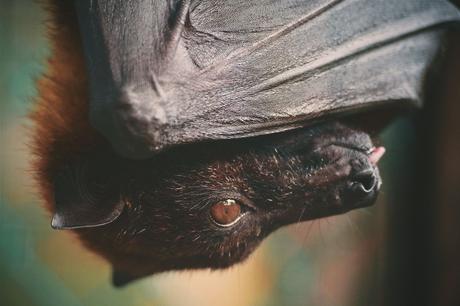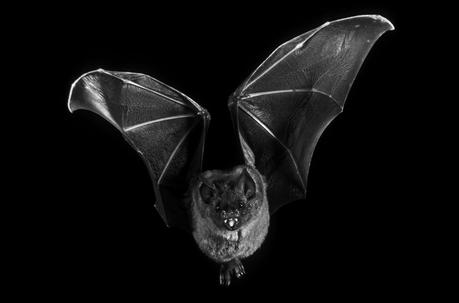 Reviewing news I came across this very interesting one. In addition to dealing with a subject that persists over time, it proposes interesting and curious developments. This curiosity lies, in my opinion, in this source of study being an important component in the vampire myth. The figure of the bat is always present in vampire stories, in turn, we know that one of the characteristics of the vampire is the life absent of longevity.
Reviewing news I came across this very interesting one. In addition to dealing with a subject that persists over time, it proposes interesting and curious developments. This curiosity lies, in my opinion, in this source of study being an important component in the vampire myth. The figure of the bat is always present in vampire stories, in turn, we know that one of the characteristics of the vampire is the life absent of longevity.Eternal youth now associated with a genetic study involving this real species, although loaded with mythology.
Bat DNA could be the secret to a long and healthy life
"The study, which benefited from an EU research grant for the project AGELESS, looked at the telomeres of four different species of wild bats to determine what role, if any, they play in bat longevity. Among mammals, bats are the longest-lived species relative to their body size. In fact, of the 19 mammal species that live longer lives than humans when body size is factored in, 18 are bats.
Using data gained from more than 60 years of field studies, the project team tried to find out whether telomeres shorten with age in the bat species Rhinolophus ferrumequinum, Miniopterus schreibersii, Myotis bechsteinii and Myotis myotis.
Telomeres are the caps at the end of each strand of DNA that protect our chromosomes. As we age, telomeres get shorter and shorter until they can no longer do their job, which causes our cells to begin breaking down. Once this process is triggered, our tissues begin to degenerate and die.[...]
Further tests were then conducted to compare the genome of Myotis species with those of 52 other mammals. Analyses of 225 genes associated with telomere maintenance identified 21 that may play a role in preventing telomere shortening in Myotis bats. ATM and SETX in particular, which are responsible for repairing and preventing DNA damage, may be the driving force behind the species' remarkable longevity.
If these genes are the reason why telomeres don't shorten in Myotis species, then they might have excellent therapeutic potential, since bats rarely have cancer. The maintenance of telomere length without telomerase involvement is especially important for humans, since telomerase expression is found in about 90 % of human cancers.
The AGELESS (Comparative genomics / 'wildlife' transcriptomics uncovers the mechanisms of halted ageing in mammals) project has helped to deepen understanding of the mechanisms that bats have evolved in order to give them their long lifespans. It has also brought scientists a step closer to discovering how to stop ageing and alleviate age-related illnesses in humans."
Source Revisando noticias me topé con esta muy interesante. Además de tratar un tema que persiste a lo largo del tiempo, propone avances interesantes y curiosos. Esta curiosidad radica, en mi opinión, en esta fuente de estudio al ser un componente importante en el mito vampírico. La figura del murciélago siempre está presente en las historias de vampiros, a su vez, sabemos que una de las características del vampiro es la vida ausente de longevidad.
Revisando noticias me topé con esta muy interesante. Además de tratar un tema que persiste a lo largo del tiempo, propone avances interesantes y curiosos. Esta curiosidad radica, en mi opinión, en esta fuente de estudio al ser un componente importante en el mito vampírico. La figura del murciélago siempre está presente en las historias de vampiros, a su vez, sabemos que una de las características del vampiro es la vida ausente de longevidad.La Juventud eterna ahora asociada a un estudio genético que involucra a esta especie real, aunque cargada de mitología.
"El estudio, que se benefició de una beca de investigación de la UE para el proyecto AGELESS, analizó los telómeros de cuatro especies diferentes de murciélagos salvajes para determinar la función, si la hubiera, que desempeñan en la longevidad de los murciélagos. Entre los mamíferos, los murciélagos son la especie más longeva en relación con el tamaño de su cuerpo. De hecho, de las diecinueve especies de mamíferos que viven más tiempo que los humanos cuando se tiene en cuenta el tamaño corporal, dieciocho son murciélagos.
Empleando datos obtenidos durante más de sesenta años de estudios de campo, el equipo del proyecto intentó averiguar si los telómeros se acortan con la edad en las especies de murciélagos "Rhinolophus ferrumequinum", "Miniopterus schreibersii", "Myotis bechsteinii" y "Myotis myotis".
Los telómeros son los extremos que hay al final de cada hebra de ADN y que protegen nuestros cromosomas. A medida que envejecemos, los telómeros se vuelven cada vez más cortos hasta que ya no pueden hacer su trabajo,lo cual hace que nuestras células comiencen a descomponerse. Una vez que este proceso se activa, nuestros tejidos comienzan a degenerarse y mueren.[...]
Posteriormente, se realizaron pruebas adicionales para comparar el genoma de las especies del género "Myotis" con los de otros cincuenta y dos mamíferos. Los análisis de 225 genes asociados con el mantenimiento de los telómeros identificaron veintiún genes que pueden desempeñar una función en la prevención del acortamiento de telómeros en murciélagos del género "Myotis". En particular, el gen ATM y el gen SETX, que son responsables de reparar y prevenir el daño del ADN, pueden ser los causantes de la notable longevidad de la especie.
Si estos genes son el motivo por el que los telómeros no se acortan en el género "Myotis", podrían tener un excelente potencial terapéutico, ya que los murciélagos rara vez tienen cáncer. El mantenimiento de la longitud del telómero sin implicación de la telomerasa es especialmente importante para los seres humanos, ya que la
expresión de la telomerasa se encuentra en aproximadamente el 90 % de los cánceres humanos.
El proyecto AGELESS (Comparative genomics / 'wildlife' transcriptomics uncovers the mechanisms of halted ageing in mammals) ha ayudado a profundizar en la comprensión de los mecanismos que han desarrollado los murciélagos para darles una esperanza de vida larga. Asimismo, ha acercado un paso más a los científicos al descubrimiento de cómo detener el envejecimiento y paliar las enfermedades relacionadas con la edad en los seres humanos."
Cover photo: Pedro Jarque Krebs-Peru-2018

